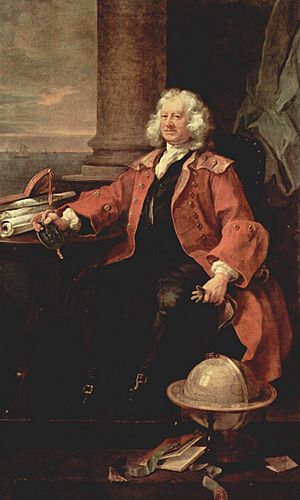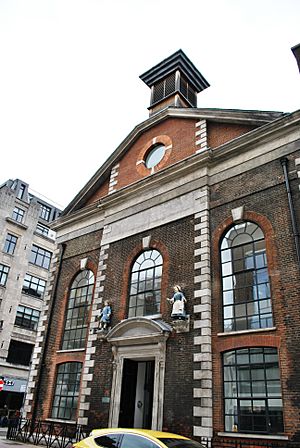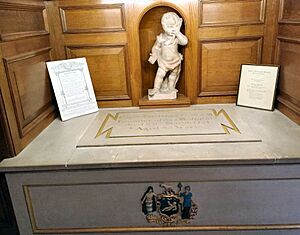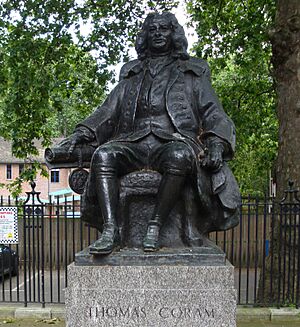Thomas Coram facts for kids
Quick facts for kids
Thomas Coram
|
|
|---|---|

Portrait by William Hogarth, 1740.
|
|
| Born | c. 1668 |
| Died | 29 March 1751 |
| Nationality | English |
| Occupation | Shipwright, sea captain, philanthropist |
| Spouse(s) | Eunice Waite |
Thomas Coram (born around 1668 – died 1751) was an English sea captain. He was also a philanthropist, meaning he worked to help others. He is famous for starting the London Foundling Hospital. This hospital was a special home for children who had been left alone on the streets of London. Many people say it was the world's first official charity.
Contents
Who Was Thomas Coram?
Thomas Coram was born in Lyme Regis, England. His father was likely a master sailor. Thomas started working on ships when he was only 11 years old. Because of this, he did not get a proper school education.
In 1694, he moved to what is now Dighton, Massachusetts, in America. Coram lived there for ten years. He even started a shipyard in Dighton. In 1703, he gave 59 acres of land in Taunton for a school. He also gave books to a church library there.
Returning to London
In 1704, when he was 36, Coram moved back to London. He helped pass a law that encouraged importing tar from the colonies. During a big war called the War of the Spanish Succession, he commanded a merchant ship. This is how he earned the title "Captain."
Coram was known for his strong public spirit. He was described as an "honest" and "disinterested" person. He helped change rules about wood imports from other countries. In 1732, he became a trustee for the Georgia Colony. This colony was founded by James Oglethorpe.
In 1735, Coram suggested a plan to help unemployed English workers. He wanted them to settle in Nova Scotia. This plan was eventually put into action before he died.
Founding the Foundling Hospital
While living near London, Coram often saw babies left alone on the streets. Many of these babies were dying. This made him very sad and determined to help. He decided to create a home for these abandoned children. This home would be called a foundling hospital.
Coram worked for 17 years to make his dream happen. He convinced many important ladies to support his idea. Finally, in 1739, King George II signed a special paper. This paper officially created the Foundling Hospital. Many people donated money to help. The first meeting for the hospital was held in November 1739.
The Hospital's First Home

At first, the hospital rented some houses in Hatton Garden. Children were first welcomed there in 1741. Later, a piece of land was bought in Bloomsbury for £7,000. The owner of the land, Lord Salisbury, insisted that all his land be bought. However, he also donated £500 himself.
The first stone for the new hospital building was laid on September 16, 1742. By October 1745, part of the building was ready. The children moved from Hatton Garden to the new Bloomsbury site.
Famous Supporters
Many famous people became interested in the hospital. The artist William Hogarth was a big supporter. In 1740, he gave his famous portrait of Coram to the hospital. Hogarth also donated other paintings and lottery tickets.
The famous composer George Frideric Handel also helped. He gave special music performances at the hospital in 1749 and 1750. These events helped raise money and attention for the hospital.
Thomas Coram's Later Life
Coram remained very interested in the hospital. He was elected to the General Committee until 1742. However, he later received too few votes to stay on the committee. The exact reason he was removed is not fully clear. Some say he spread rumors about other leaders. Others believe he criticized how the hospital was run.
In his later years, Coram supported a plan to educate Native American girls in America. He had lived and worked with Native Americans. He believed it was very important for girls to get an education. He thought that educated mothers would raise good children. This idea also influenced his plans for the Foundling Hospital. He wanted girls there to receive an education too.
After his wife died, Coram had money problems. People raised money to help him. He said he was not ashamed to be poor because he had never wasted his money. In 1749, he was given a yearly payment of £161. The Prince of Wales donated £21 of this amount each year.
Thomas Coram's Family
Thomas Coram said he came from a "virtuous good parentage." His mother died when he was very young, in 1671. Not much is known about his father, but he was likely a master sailor.
While in Massachusetts, Thomas met and married Eunice Waite. They were married in 1700. They had a happy marriage that lasted 40 years until her death. Even though Coram dedicated his life to helping children, he and Eunice did not have any children of their own.
Death and Burial


Thomas Coram died on March 29, 1751, at 83 years old. He was buried on April 3 in the chapel of the Foundling Hospital. A statue of him was put in front of the building 100 years later. People described him as an honest and kind sailor.
In 1935, the Foundling Hospital moved to a new location. The old building was torn down. A special chapel was built at the new hospital. This chapel had a crypt designed to hold Coram's remains. In 1955, the building was sold. Coram's remains were moved to the Church of St Andrew, Holborn in London. The chapel is still standing today. It is now part of Ashlyns School.
Thomas Coram's Legacy
William Hogarth, Coram's friend, was one of the first leaders of the Foundling Hospital. He painted a famous portrait of Coram. This painting can now be seen at the Foundling Museum in London.
Hogarth and other artists decorated the hospital's Governors' Court Room. This room had paintings by Francis Hayman, Thomas Gainsborough, and Richard Wilson. The Foundling Hospital became the first art gallery in London open to the public.
Handel allowed his famous music piece, Messiah, to be performed to benefit the hospital. He also gave the hospital the original music for the "Hallelujah Chorus." He even wrote a special song just for a performance at the hospital. This song is now called the Foundling Hospital Anthem.
The Foundling Hospital charity still exists today. It is now known as Coram. The original hospital site is now a children's park. It is called Coram's Fields. This park does not allow adults to enter unless they are with children. Coram's Fields also provides services for local children and young people. These include a Youth Centre and a free Sports Programme.
In 2000, Jamila Gavin wrote a children's book called Coram Boy. The book is about the Foundling Hospital. It was later made into a play by Helen Edmundson. The play first opened in London in 2005. It also had a short run on Broadway.
See also
 In Spanish: Thomas Coram para niños
In Spanish: Thomas Coram para niños
- Coram Family
- Foundling Hospital
- Foundling Museum
- Thomas Coram Foundation for Children



